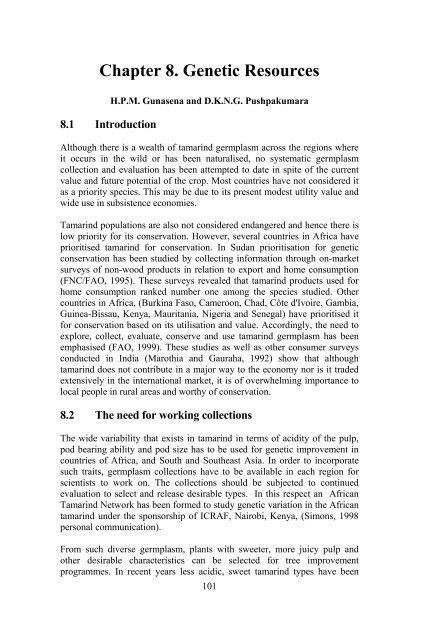Tamarind monograph.pdf - Crops for the Future
Tamarind monograph.pdf - Crops for the Future
Tamarind monograph.pdf - Crops for the Future
Create successful ePaper yourself
Turn your PDF publications into a flip-book with our unique Google optimized e-Paper software.
Chapter 8. Genetic Resources<br />
8.1 Introduction<br />
H.P.M. Gunasena and D.K.N.G. Pushpakumara<br />
Although <strong>the</strong>re is a wealth of tamarind germplasm across <strong>the</strong> regions where<br />
it occurs in <strong>the</strong> wild or has been naturalised, no systematic germplasm<br />
collection and evaluation has been attempted to date in spite of <strong>the</strong> current<br />
value and future potential of <strong>the</strong> crop. Most countries have not considered it<br />
as a priority species. This may be due to its present modest utility value and<br />
wide use in subsistence economies.<br />
<strong>Tamarind</strong> populations are also not considered endangered and hence <strong>the</strong>re is<br />
low priority <strong>for</strong> its conservation. However, several countries in Africa have<br />
prioritised tamarind <strong>for</strong> conservation. In Sudan prioritisation <strong>for</strong> genetic<br />
conservation has been studied by collecting in<strong>for</strong>mation through on-market<br />
surveys of non-wood products in relation to export and home consumption<br />
(FNC/FAO, 1995). These surveys revealed that tamarind products used <strong>for</strong><br />
home consumption ranked number one among <strong>the</strong> species studied. O<strong>the</strong>r<br />
countries in Africa, (Burkina Faso, Cameroon, Chad, Côte d'Ivoire, Gambia,<br />
Guinea-Bissau, Kenya, Mauritania, Nigeria and Senegal) have prioritised it<br />
<strong>for</strong> conservation based on its utilisation and value. Accordingly, <strong>the</strong> need to<br />
explore, collect, evaluate, conserve and use tamarind germplasm has been<br />
emphasised (FAO, 1999). These studies as well as o<strong>the</strong>r consumer surveys<br />
conducted in India (Marothia and Gauraha, 1992) show that although<br />
tamarind does not contribute in a major way to <strong>the</strong> economy nor is it traded<br />
extensively in <strong>the</strong> international market, it is of overwhelming importance to<br />
local people in rural areas and worthy of conservation.<br />
8.2 The need <strong>for</strong> working collections<br />
The wide variability that exists in tamarind in terms of acidity of <strong>the</strong> pulp,<br />
pod bearing ability and pod size has to be used <strong>for</strong> genetic improvement in<br />
countries of Africa, and South and Sou<strong>the</strong>ast Asia. In order to incorporate<br />
such traits, germplasm collections have to be available in each region <strong>for</strong><br />
scientists to work on. The collections should be subjected to continued<br />
evaluation to select and release desirable types. In this respect an African<br />
<strong>Tamarind</strong> Network has been <strong>for</strong>med to study genetic variation in <strong>the</strong> African<br />
tamarind under <strong>the</strong> sponsorship of ICRAF, Nairobi, Kenya, (Simons, 1998<br />
personal communication).<br />
From such diverse germplasm, plants with sweeter, more juicy pulp and<br />
o<strong>the</strong>r desirable characteristics can be selected <strong>for</strong> tree improvement<br />
programmes. In recent years less acidic, sweet tamarind types have been<br />
101

















